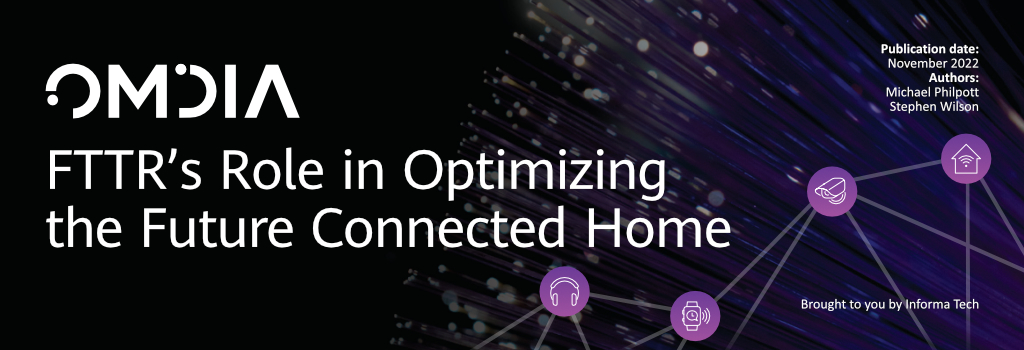FTTR’s Role in Optimizing the Future Connected Home

The in-home experience is an essential part of the modern broadband service. Lack of investment on behalf of service providers in this area has proved to quickly result in rising customer dissatisfaction, operations costs, and customer churn. Leading operators have successfully countered this with investment in both more advanced Wi-Fi hardware and smart Wi-Fi software platforms. However, as fiber-to-the-home (FTTH) rollouts continue and both the bandwidth capabilities of the broadband network and network demands from new innovative cloud applications continue to grow exponentially, there will be a need to push fiber further into the home—especially for premium customers—to guarantee ultra-high bandwidth and ultra-low latency in every corner of the home.
Although it is only currently available to the mass residential market in a handful of countries today, because of this demand and service providers’ desire to market the optimum broadband experience, Omdia forecasts robust growth in fiber to the room (FTTR) across all regions over the next 10 years.
Please read the report for more details.
FTTR’s Role in Optimizing the Future Connected HomeKey Takeaways
- Demands on the home network will continue to accelerate. The use of video-based cloud applications will continue to grow rapidly, placing increasing demands on the network as we move to new video quality standards and new innovative applications such as extended reality (XR) and the metaverse.
- The home network must keep pace. Omdia’s research clearly shows that if the home network is allowed to impair the home broadband experience, it can quickly cause significant customer dissatisfaction and soaring operational costs. Leading service providers have been successful in their investment in more advanced Wi-Fi hardware and smart Wi-Fi software, but as we move to gigabit societies, this investment alone will not be enough to provide the required quality of experience on a consistent basis for future premium customers.
- FTTR will ensure a consistent and high-quality experience. In lab trials and service provider pilots, FTTR has proved to provide a higher, more consistent level of service experience across the whole home. This includes more consistent coverage, better device handover times, less application freezing, and more consistent broadband speed. There is already a growing trend among operators to tier broadband plans not just on speed but also by features related to in[1]home network quality. By promising even greater quality, FTTR could allow the creation of yet more premium broadband tiers that fit alongside operators’ existing tariff portfolios.
- Pricing and installation strategy will be key to success. The biggest challenge with FTTR is how to deploy it efficiently and cost-effectively. Installation strategy and pricing will be key to creating viable business models and to keeping the offering attractive to the customer. There are numerous ways FTTR could be priced, including one-off fee, monthly recurring fee, and premium bundling, all of which service providers have ready experience of from their advanced Wi-Fi strategies. All strategies should be explored to find the right fit for the particular market. Service providers should also explore ways to create operational efficiencies around installation, such as combining it with existing field work for FTTH rollouts and working with property developers.
- FTTR will see robust growth to 2030 and beyond. With the acceleration in growth in FTTH networks and the broadband service providers’ desire to differentiate around premium-quality broadband services, Omdia forecasts robust growth in the FTTR share of residential FTTH subscriptions across all regions. In 2030 the figure will be highest in China at 25%, followed by 15% in North America and 12% in Western Europe. Globally, this is equivalent to 8% of all households.
- Pricing and installation strategy will be key to success. The biggest challenge with FTTR is how to deploy it efficiently and cost-effectively. Installation strategy and pricing will be key to creating viable business models and to keeping the offering attractive to the customer. There are numerous ways FTTR could be priced, including one-off fee, monthly recurring fee, and premium bundling, all of which service providers have ready experience of from their advanced Wi-Fi strategies. All strategies should be explored to find the right fit for the particular market. Service providers should also explore ways to create operational efficiencies around installation, such as combining it with existing field work for FTTH rollouts and working with property developers.
Appendix
Author
Michael Philpott
Research Director, Digital Consumer Services
Stephen Wilson
Principal Analyst, Broadband Tech
Further Reading
FTTR’s Role in Optimizing the Future Connected Home (publicly available)
https://omdia.tech.informa.com/commissioned-research/articles/fttrs-role-in-optimizing-the-future-connected-home